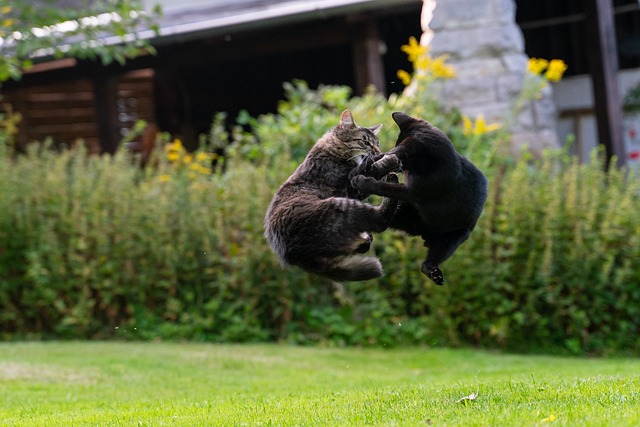If you have multiple cats, chances are you know The Sound.
It’s different in every multicat home. It may be a growl, a cat hissing, a scurrying, or even a screeching sound. Despite the differences in what exactly The Sound is, it has the same meaning: the cats are fighting again and now you need to stop a cat fight.
Depending on the dynamics of your clowder, this may be a regular occurrence or it may happen only rarely. When it does happen, you need to act quickly to stop the fighting cats from hurting each other or causing damage to your home. How exactly does one stop a cat fight? There are a lot of not so great methods suggested that may actually create a bigger headache for you long term. Thankfully, you stumbled on my blog so I’m here to teach you how to properly break up a cat fight!
Stop A Cat Fight Safely
If you don’t have any clue what to do (or you read one of the not so high quality guides I found while researching this post), you may first think to grab one of the cats or use your hands to separate them. I’m going to be very clear about this: I do not recommend doing this under any circumstances.
Reaching your hands in to break up the fight isn’t a great choice as cat bites are very dangerous even if they don’t cause a lot of physical damage to your body. The reason is simple: bacteria. A cat bite can quickly become infected due to their sharp and long front teeth. These infections may not be mild, either: bites may lead to sepsis or even death within 24 to 72 hours of symptoms showing up. Yikes!

Even if you’ve broken up a fight before and you aren’t the target of the fight, you’re taking a huge risk by sticking your hands between your cats. Cats may redirect their frustration toward you or accidentally bite you. If you do anything to scare them, whether purposefully or unintentionally, they may also see you as a threat so you may end up being bitten.
The only time you should use your hands to directly stop a fight is if you have thick bite gloves on. They are a great thing to keep on hand in case you need them, but they’re also not the best way to stop a cat fight. Let’s go over some better methods.
Stopping A Minor Fight
If the cat fight is relatively minor or hasn’t started yet, you may be able to de-escalate the situation. Distraction is your friend in these scenarios. Calmly call one of the cats to you to get their attention away from the other cat. You want to call the more calm cat as they’ll be more likely to listen to you. You can also try shaking a bag of treats or using a toy to get the cats to focus on something besides each other.
The cats will likely be pretty fixated on each other if they’re bordering on fighting so there’s an important caveat to the treats or toys suggestion. A toy your cat is lukewarm about isn’t going to be a great choice. If your cat seems to have a favorite toy at the moment, you want to use that toy (and if you haven’t found a toy your cat loves, you need to try the Cat Dancer because it’s the toy I can get most of my clients’ cats playing with). If you are using treats, use their favorite treats.
After you get the cats distracted from each other, gently guide them to separate areas of your home so they can be alone with a closed door between them. The last thing you want is for a more serious conflict to arise right after you get them separated. Give them a chance to cool down before they meet again and, in the meantime, figure out what the source of the tension between them was.
Use A Barrier To Break Up A Fight
A lot of guides on cat fights suggest using methods like squirt bottles, making a loud noise, or doing something to startle a cat. I make my thoughts on squirt bottles very clear and this is one situation where they can be especially harmful unless you really don’t have another choice. If you spook your cat with a spritz of water or a loud noise, they’re going to end up being more fearful than they were before. Their level of fear will go up and they’ll be more likely to feel the need to defend themselves.
If you are breaking up a fight in a home, using fear or startle-based methods is going to damage the relationship between the cats by making them associate each other with fear. In other words, you’re going to be breaking up fights more and more frequently. It might temporarily disrupt the fight, but it will lead to long-term problems.
That said, if the cats are going at each other, there is a risk of serious injury, and you don’t have anything else around, they can be a last resort. You have to weigh the pros and cons of the specific situation you’re dealing with, but I prefer using other methods first especially if this is a long term problem.
A Safer Solution
If possible, instead of startling your cats, you want to place a barrier between them. Physical barriers have three big advantages over startle-based methods: First, they instantly cut off the source of fear and stress for the cats. The cats don’t see each other anymore so, while they likely still know the other cat is there, the intensity is less. This allows the cats to begin the process of calming down.
Second, a physical barrier protects the cats from hurting each other. The barrier blocks the cats (and their teeth) from making contact with each other. A noise isn’t going to do that. By using a barrier, you’ve made a dangerous situation less dangerous very rapidly.
Third, the barrier can double as a way to gently guide one of the cats to a separate space if needed once you’ve successfully stopped the cat fight. After you get the cats separated, they will need time to cool down. During this period, don’t attempt to pick up the cats as you may get injured. You want to keep the cats separated for at least 24 to 48 hours, though if they seem stressed out or are still acting off, you may need to do a longer separation.

The Best Barriers To Separate Cats
In order for a barrier to effectively stop a cat fight, it needs to have certain qualities. A flimsy sheet isn’t going to do much to protect the cats and they may still be able to partially see each other. Instead, you want to look for something with a bit more oomph to it.
One of the easiest barriers you can use is a cardboard box that’s flattened to slide between the cats. It’s sturdy, will effectively prevent the cats from seeing each other, and comes free with most online purchases. Plus, it can be folded flat and stashed in easily accessible but hidden places around the home.
Thick blankets or a large beach towel are great options that can also be easily stashed around your home. They’re not as sturdy as the cardboard, but they’ll do the job of stopping the cats from seeing each other. Plus, if absolutely necessary and as a last resort, tossing a towel over one of the cats may give you a chance to safely get the other cat out of the room. You can also use the blanket/towel to provide some protection for yourself from sharp teeth.
In an emergency, get creative. As long as it’s thick, solid, and won’t hurt the cats, it can be used. Pillows, couch cushions, a sweater from that pile of clean clothes you’ve been meaning to put away… You can make it work in a pinch. Heck, even a laundry basket over one cat can be enough to protect the other cat from them while not putting you in danger.
Getting The Cats To Another Room
Once you’ve separated the cats visually, you need to get them to the other room. If possible, guide the cats away using a toy, treats, or another distraction. You can use cardboard or towel to guide one cat away and that may be all there is to it. Sometimes the cats may need a little more gentle guidance. If needed, a broom with soft bristles can allow you to keep your distance while guiding the cat to the other room. It can also be used to buy you more time to get a more solid barrier.
Once you’ve gotten the cats to different rooms, you can breathe a little easier. You did it! The cat fight is over!
… For now.
In reality, once you break up a cat fight and get safely separate the cats from each other, you’ll need to let them decompress a bit before you interact with them. You’ll also potentially need to solve the underlying problem or problems that led to the altercation in the first place. You may need to repair the cats’ relationship. If your cats are fighting frequently, it may be a good time to call in a professional. Consider reaching out to your veterinarian or a cat behaviorist who can help you come up with a long-term solution.










